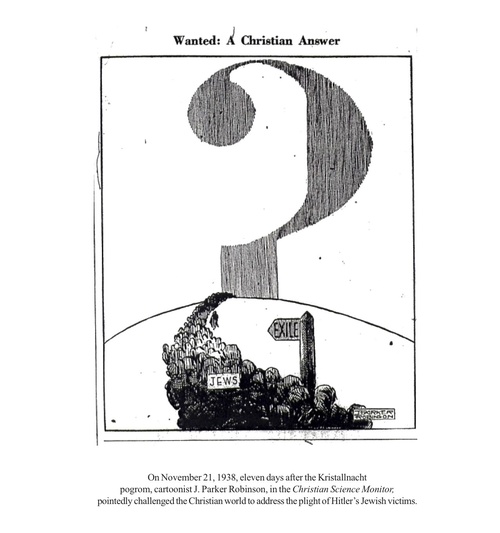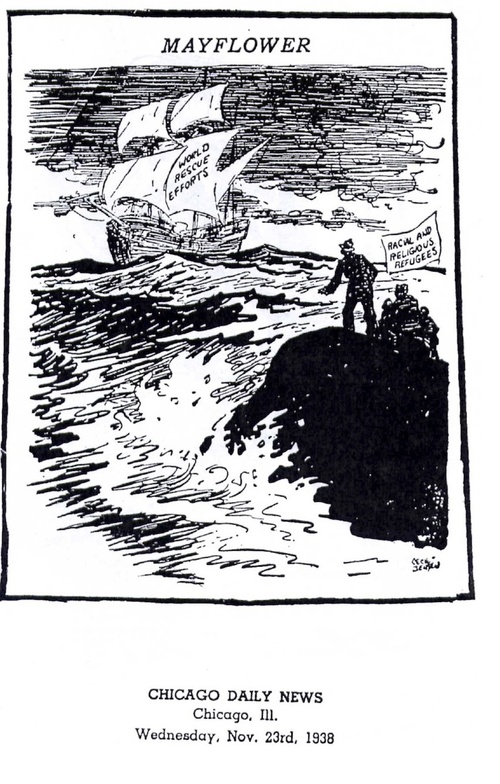The American Cartoonists Who Spoke Out Against Kristallnacht
 by Rafael Medoff / JNS.org
by Rafael Medoff / JNS.org
JNS.org – “I could scarcely believe that such a thing could occur in a 20th-century civilization,” President Franklin Roosevelt declared in the wake of the Nazis’ Kristallnacht pogrom, which devastated the German Jewish community 75 years ago next month.
Most Americans, like their president, were appalled to read of Nazi stormtroopers burning down hundreds of synagogues, ransacking thousands of Jewish-owned businesses, murdering some one hundred Jews, and hauling 30,000 more off to concentration camps, from Nov. 9-10, 1938. In the days following the pogrom, three American editorial cartoonists would try to channel the public’s sympathy for the victims into concrete steps to help German Jewry.
In response to Kristallnacht, President Roosevelt recalled the U.S. ambassador from Germany for “consultations” and extended the visitors’ visas of the approximately 12,000 German Jewish refugees who were then in the United States. But at the same time, FDR announced that liberalization of America’s tight immigration quotas was “not in contemplation.”
In the wake of Kristallnacht, humanitarian-minded Members of Congress introduced legislation to aid German Jewry. The Wagner-Rogers bill proposed the admission of 20,000 German refugee children outside the quotas. Nativist and isolationist groups vociferously opposed the Wagner-Rogers bill.
Typical of the opposition’s perspective was a remark by FDR’s cousin, Laura Delano Houghteling, who was the wife of the U.S. Commissioner of Immigration. She warned that “20,000 charming children would all too soon grow into 20,000 ugly adults.”
An appeal to FDR by First Lady Eleanor Roosevelt to support Wagner-Rogers fell on deaf ears, and an inquiry by a Congresswoman as to the president’s position was returned to his secretary marked “File No action FDR.” Mindful of polls showing most Americans opposed to more immigration, Roosevelt preferred to follow public opinion rather than lead it. Without his support, the Wagner-Rogers bill was buried in committee.
Ironically, when Pets Magazine the following year launched a campaign to have Americans take in pure-bred British puppies so they would not be harmed by German bombing raids, the magazine was flooded with several thousand offers of haven for the dogs.
Most American editorial cartoonists, like most Americans, exhibited little interest in the plight of Germany’s Jews. But there were exceptions. A handful of cartoonists used their platforms not only to express sympathy for the refugees but also to call for practical steps to help them.
Six days after Kristallnacht, Paul Cormack, staff cartoonist for the Christian Science Monitor, drew a cartoon titled “The Best Answer to Race Persecution.” It showed a large hand, labeled “Humanity,” handing a document titled “Assistance” to a crowd of Jewish refugees.
Five days later, the Christian Science Monitor published another editorial cartoon responding to Kristallnacht, this time by J. Parker Robinson. It showed a mass of people, labeled “Jews,” marching past a sign pointing to “Exile,” with a giant question mark looming over the horizon. He titled the cartoon “Wanted: A Christian Answer.” The question was the fate of the Jews; the answer, the cartoonist insisted, was for Christians to accept their moral responsibility to help the downtrodden.

A Christian Science Monitor editorial cartoon, by J. Parker Robinson, responding to Kristallnacht. Photo: Courtesy of The David S. Wyman Institute for Holocaust Studies.
Meanwhile, in the pages of the Chicago Daily News, another cartoonist pleaded for help for Germany’s Jews. Staff cartoonist Cecil Jensen drew a group of Jewish refugees on a large rock, surrounded by turbulent ocean waves. They can see, in the distance, a 17th century-style ship, labeled “World Rescue Efforts.” Whether or not the ship will save the refugees is unclear. Jensen titled the cartoon “Mayflower,” invoking America’s own powerful historical symbol of refugees from religious persecution reaching a safe haven.

In the pages of the Chicago Daily News, cartoonist Cecil Jensen pleaded for help for Germany's Jews. Photo: Courtesy of The David S. Wyman Institute for Holocaust Studies.
Sadly, few Americans heeded the appeals of Paul Cormack, J. Parker Robinson, and Cecil Jensen, despite the horrors of Kristallnacht. When a “Mayflower” ship called the St. Louis approached America’s shores just a few months later, President Roosevelt turned it away.
Expressions of sympathy were not matched by deeds. There were no U.S. economic sanctions against Nazi Germany, no severing of diplomatic relations, no easing of immigration quotas.
The Roosevelt administration’s muted reaction to Kristallnacht foreshadowed the terrible silence with which it would greet the Nazis’ Final Solution.
Dr. Rafael Medoff is founding director of The David S. Wyman Institute for Holocaust Studies. This feature is adapted from his forthcoming book,” Cartoonists Against the Holocaust,” coauthored with Craig Yoe.
 US Stops UN From Recognizing a Palestinian State Through Membership
US Stops UN From Recognizing a Palestinian State Through Membership Jordan Reaffirms Commitment to Peace With Israel After Iran Attack, Says Ending Treaty Would Hurt Palestinians
Jordan Reaffirms Commitment to Peace With Israel After Iran Attack, Says Ending Treaty Would Hurt Palestinians ‘Crisis at Columbia’: Elite University Spirals Into Chaos Against Backdrop of School President’s DC Testimony
‘Crisis at Columbia’: Elite University Spirals Into Chaos Against Backdrop of School President’s DC Testimony ‘A Time for Vigilance’: FBI Director Says Agency on Alert for Threats Against Jewish Community During Passover
‘A Time for Vigilance’: FBI Director Says Agency on Alert for Threats Against Jewish Community During Passover New Haggadah Released for Israeli Soldiers in Gaza Ahead of Passover
New Haggadah Released for Israeli Soldiers in Gaza Ahead of Passover ADL Data Reveals Alarming Campus Antisemitism, Despite Strong Jewish Life
ADL Data Reveals Alarming Campus Antisemitism, Despite Strong Jewish Life New Hospital Approved for Construction in Southern Israel Amid Gaza War
New Hospital Approved for Construction in Southern Israel Amid Gaza War UN Security Council to Vote Thursday on Palestinian UN Membership
UN Security Council to Vote Thursday on Palestinian UN Membership New Play Opening in NY Recounts Verbatim Testimonies From Oct. 7 Survivors, Families of Victims
New Play Opening in NY Recounts Verbatim Testimonies From Oct. 7 Survivors, Families of Victims




 Gaza Terrorist Spokesperson Reveals How Media Falls for Terror Group’s Lies
Gaza Terrorist Spokesperson Reveals How Media Falls for Terror Group’s Lies Jordan Reaffirms Commitment to Peace With Israel After Iran Attack, Says Ending Treaty Would Hurt Palestinians
Jordan Reaffirms Commitment to Peace With Israel After Iran Attack, Says Ending Treaty Would Hurt Palestinians ‘Washington Post’ Platforms Superficial ‘As a Jew’ Op-Ed on Israel & Gaza
‘Washington Post’ Platforms Superficial ‘As a Jew’ Op-Ed on Israel & Gaza US Stops UN From Recognizing a Palestinian State Through Membership
US Stops UN From Recognizing a Palestinian State Through Membership Understanding the Meaning of Elijah This Passover
Understanding the Meaning of Elijah This Passover